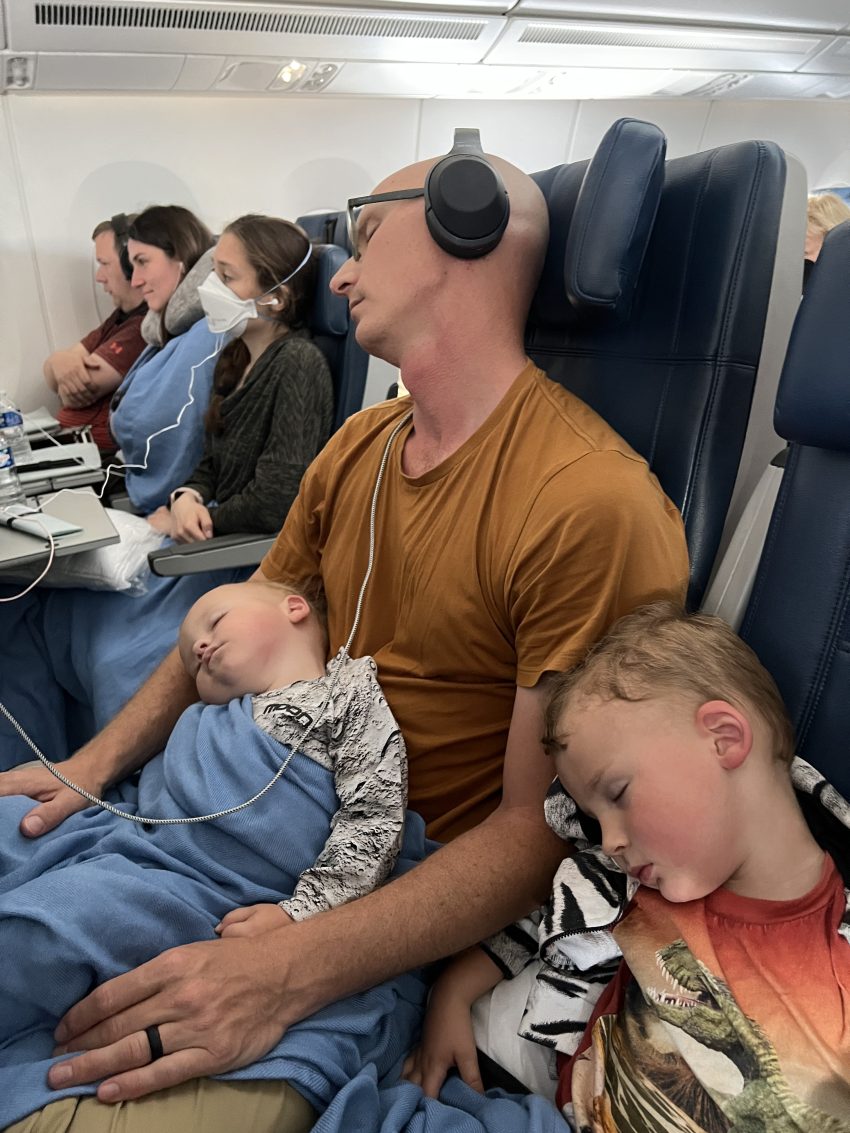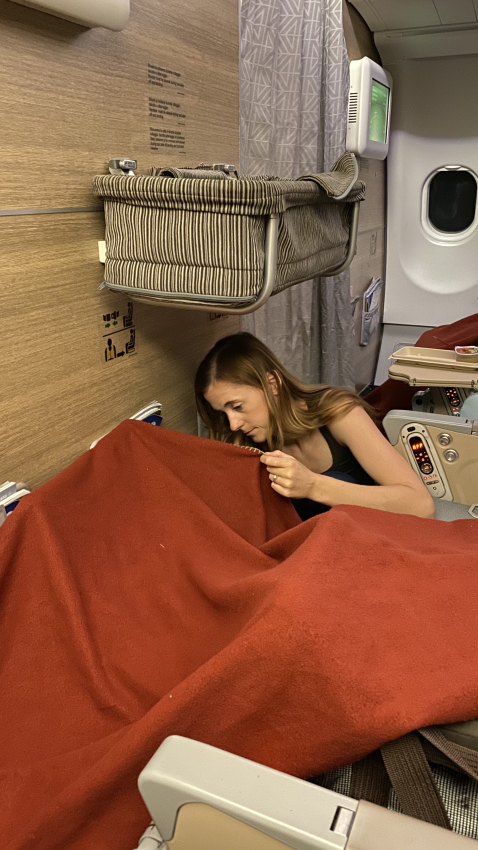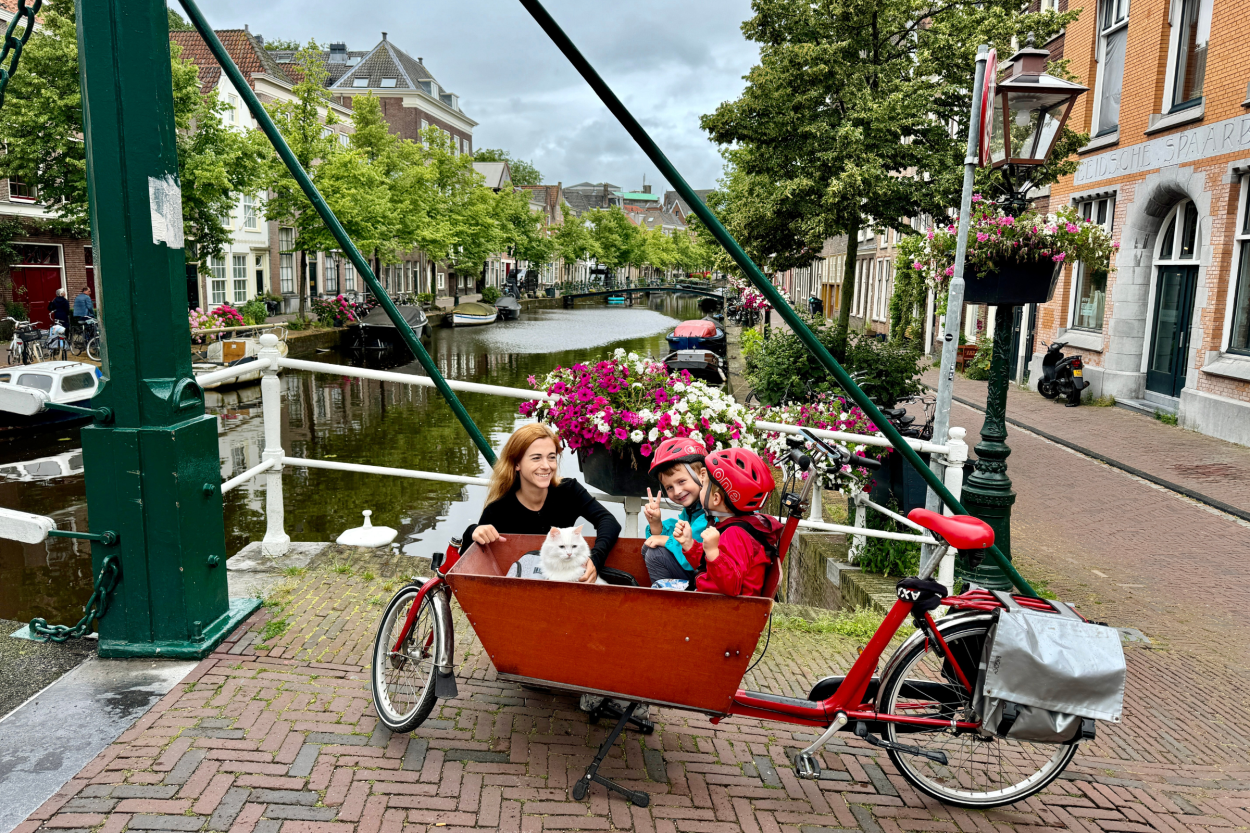Airplane Bassinet: How to Book & Use
Wait what? Do planes have baby bassinets? Is the airplane bassinet worth it? Do airplane bassinets cost extra?
An airplane bassinet on a long-haul flight can be a lifesaver! Many first-time parents don’t know how to book them or whether they need to pay extra for them, so after over 100 flights with babies, toddlers, and pets (or all of them together on at least 50 flights) I have all the answers for you!
After so many flights with or without bassinets, we have found that they can be hit or miss, and we discovered a few cons during our experience with airline bassinets.
What Is an Airplane Bassinet?
An airplane bassinet for babies is an in-flight bassinet cot that is available on most international large flights for those flying with an infant in-lap.
They’re sometimes called baskets, airplane baby beds, or skycots.
When you book an infant ticket for children under 2 years of age (if you’re American, keep in mind that you MUST book a ticket for an infant on an international flight – you cannot add an infant to an international flight at the airport just like you do for domestic US flights), an infant is required to sit on an adult’s lap unless you purchase a seat for an infant and bring a car seat.
On all non-US airlines, a baby sitting on an adult’s lap must also wear a seat belt that attaches the adult’s seat belt.
We all know that holding a child for hours can be tiring, so this is when a bassinet comes in handy. A baby bassinet is a place where a baby can lie down and sleep in flight. It hangs from the walls of the aircraft on a special shelf on designated seats called bassinet seats.
Bassinets vary between airlines and airplane types! They can be bigger, or smaller, and some even recline, but usually, it’s rectangular boxes with velcro or zipper on top for safety that must be closed at all times when the baby is in the skycot.

Where are the Bassinet Seats?
The airplane seat where the bassinet basket is used is commonly referred to as the “bassinet seat”. In economy class, it may also be called the bulkhead seats or bulkhead row (usually with either the toilets, or cabin divider in front of you).
However, keep in mind that not all bulkhead rows have bassinets.
In business class and first class cabins, many airlines now have special shelves where the bassinet is fitted on a flat surface right by your seat. These are great as your movement getting in and out of your seat is not restricted by the bassinet unlike it is often in economy class.

If you’re flying with a pet you cannot sit in the bassinet seat but some airlines will still bump you up when they’re too busy to switch you. In this case, your pet carrier might sit on a seat instead of underneath the seat (this happened to us 3 times and 4th time I requested to switch out of bassinet seats)
Is There an Age or Weight Limit on Airplane Bassinets?
Bassinets are great as long as your baby is small. There is no standardized airplane bassinet, but in most cases, they may be requested for infants up to 18 months of age, but the recommended age limit for bassinet use on international flights is a maximum 8 months.
Many airlines prioritize smaller babies so if two people request a bassinet the younger one will get it -which makes total sense.
In fact, most airlines will not let you have a baby in a bassinet if they can sit up unassisted for safety reasons. Don’t believe these idiotic TikTok videos of people trying to squeeze their almost 2-year-old into the bassinet – no sane flight attendant will let you do that.
If you have a baby that’s in the 70th or higher percentile for weight or height then I’ll say even at 8 months it might be a tight and uncomfortable fit on some airlines.
Dylan was always a tall baby and when we had a bassinet on the most recent flight, he pretty much hated it. It was way too small for him already, he couldn’t turn on his size in it and refused to fall asleep.

Do You Have to Pay Extra for a Baby Bed on the Plane?
The biggest myth about bassinets is that you need to pay extra for them. They’re absolutely FREE.
On some airlines, you might need to pay extra for the bulkhead seat as it’s a “better seat”, but that’s rare.
How Do You Get the Bassinet on a Plane?
In terms of booking them, it depends on the airline. For instance, Emirates offers plenty of bassinets and automatically assigns you to one after booking your infant. I didn’t even need to call and request it. Plus we got a free baby package full of toys and useful items.
Delta or American usually only have 2 bassinets on the plane and they block the seats (AKA seats will appear as taken when you look at the seat map). You can only receive these seats at the gate.
Other airlines might require you to pre-book these seats by calling them in advance. I recently witnessed one family being surprised. After all, they couldn’t get a bassinet at the gate because they did it with Delta in the past, as these seats were already booked due to different policies.
That said, always enquire with the airline to avoid surprises. I included a list of airlines and their bassinet policies at the end of this post.
Can You Use a Bassinet and Carseat?
On most airplanes, you cannot. However, there are some that will allow it, as long as the car seat is narrow enough to fit within the two seats as some spots in that row have non-moveable armrests.
Note that if you pre-book a seat for your baby under 2 years of age on board you won’t be given bassinet seats.
Possible Cons of Airline Bassinets
We used bassinets on various flights and I must say that on some flights when our babies were under 5 months old, they worked great, but anything after was a nightmare and I was trying to swap out of bassinet seats – which wasn’t an issue because everyone wants them.
If you’re flying in economy class, some people love the bulkhead seats because there’s usually more legroom and no seat in front of you.
However, these seats come with cons as well. To start with, they’re often right next to toilets which often leads to lines, people opening and closing the doors, and making other noises that make it hard for the baby to sleep.
They’re also almost always under a bright screen with a flight map which doesn’t help (you can ask the flight attendant to turn it off, but not all of them will do it), which leads more parents to purchase CoziGo – a smaller version of SlumberPod for strollers and bassinets.
Most airlines will ask you to take the baby out of it when there’s turbulence and naturally, the bassinet is folded away for takeoff and landing. The only exception is Virgin Atlantic and British Airways because the bassinet has a harness.
We had one flight when Dylan was basically only allowed to be in the bassinet for half an hour before they turned the seatbelt sign on and we had to take him out – on an 8-hour flight!
This brings me to the next point – if you suddenly discover there is turbulence or that your child doesn’t fit in the bassinet, the bulkhead seats don’t have moveable armrests (some newer airlines like Air Tahiti Nui have movable armrests in the middle in a 3 or 4-seater configuration) which makes it super uncomfortable for another child to spread out over parents.
Not to mention that it’s not possible to eat on those trays that come out of the armrest when holding a baby because they’re tighter than those coming out of the back of the seat in front of you.
Most importantly, you cannot have any bags on the floor for take-off and landing, which you might think its not an issue… until you sit on the tarmac for an hour after landing because there’s an issue and you can’t get up or open the bin while your child is screaming for milk, snacks, diaper, or anything that’s in your diaper bag stowed away.

Airlines Bassinet Policies & How to Book Them
Different airlines have different policies regarding booking and/or using bassinets (see below). Most are for babies six months old or younger and have a weight limit of about 20 lbs.
They also can only be used for babies who are not yet able to sit upright unassisted (which makes sense, since you don’t want your baby trying to climb out of the bassinet mid-flight!).
- Aer Lingus – call book. Available for babies without purchased seats.
- Aeroflot – call to book for babies under 1 (and up to 11kg).
- Aeromexico – available if you buy AM Plus Seat but not guaranteed – subject to check-in availability.
- Air Canada – call to request (first come first serve at check-in). Only available on some planes and up to 12 kg or until baby sits upright.
- Air France – call to request up to 48h before departure. Only available for babies up to 10 kg and less than 70 cm (27″)
- Air India – call to request, but subject to fitting into the bassinet so babies under 70 cm height.
- Air Mauritius – call to book. For babies under 12 months or up to 11 kg or 74 cm tall.
- Air New Zealand – you can book online (seats are marked with a baby symbol). For infants up to 8 months and less than 11 kg.
- Air Seychelles – call to request as soon as you book your ticket for babies under 6 months old.
- Air Tahiti Nui – call to request for babies under and 75 cm 14kg.
- Alaska Airlines – no bassinets available.
- ITA Airways – call to request or ask at check-in for babies under 11 kg and less than 76 cm tall.
- American Airlines – bassinets available only on 777-200, 767-300, 777-300 and 787. No bassinets in First or Business class. First come, first serve upon check-in.
- ANA – call to request for babies under 10 kg.
- Asiana – call to book for babies under 71 cm tall. Bassinets for A350 Economy Class are smaller than regular.
- Avianca – contact to request. Available for babies under 12 months and under 74 cm or 11 kg.
- British Airways – both bassinets or seated cots for older children up to 2 years (or 12.5 kg) available. You can reserve online during booking.
- Cathay Pacific – Book when purchasing flights for infants up to 6 months. Not available on Airbus A321neo.
- China Airlines – call to request for babies under 6 months, 71 cm or 11 kg.
- Condor – call to request for babies under 6 months or 8 kg.
- Czech Airlines – request by calling for kids under 11 kg.
- Delta Airlines – call to request for babies under 20 lbs and 26 inches.
- EasyJet – no bassinets available.
- El Al Airlines – for babies up to 9 months old for free (Lite tickets require a charge).
- Emirates bassinets – can be booked online when picking seats. Available up to 2 years, but only if child fits so usually under 12 months and definitely under 12 kg.
- Etihad Airways – book online for babies under 11 kg and 75 cm tall.
- Eva Air – request when making a reservation. Depending on the aircraft babies might have to be smaller than 70 cm or 76 cm.
- Fiji Airways – bassinets allocated at check-in.
- Frontier Airlines – no bassinets available.
- Garuda Indonesia – call to request & distribute upon check-in for babies under 9 kg.
- Gulf Air – call to book for infants up to 7 months and less than 66 cm or 10 kg.
- JetBlue Airways – no bassinets available.
- Hawaiian Airlines – book in advance in Extra Comfort seats for babies under 20 lbs, or upgrade at check-in – subject to availability.
- Iberia – call to request for infants up to 11 kg. Might cost extra.
- Icelandair – no bassinets available.
- Japan Airlines – distributed at check-in for babies up to 10.5 kg.
- KLM – request the bassinet online. Only for babies up to 65 cm tall and 10 kg.
- Korean Air – only in economy class and Prestige class. Request online for babies under 11 kg and 75 cm.
- LATAM – request by calling for babies under 10 kg and 71 cm.
- Lufthansa – request by calling for babies under 11 kg and 67 cm. Lufhansa might automatically bump you to bassinet seats at the gate.
- Malaysia Airlines – request by calling.
- Qantas Airways – request when booking online for babies under 11 kg.
- Qatar Airways – request by calling or at booking. Not available on A380. Baby must fit in thebassinet and be under 11 kg.
- Ryanair – no bassinets available.
- Singapore Airlines – book when purchasing a flight for up to 14 kg.
- South African Airways – request by calling for babies under 10 kg and 75 cm.
- Southwest Airlines – no bassinets available.
- Sri Lankan Airlines – request must be made when booking a flight.
- Swiss International – request by calling for babies under 8 months and 11 kg.
- TAP Air Portugal – request by calling for babies under 12 months and 11 kg.
- Thai Airways – request when booking for babies under 6 months, 67 cm and 10 kg.
- Turkish Airlines – call to request.
- United Airlines – request by calling for babies under 10 kg.
- Virgin Atlantic – request online.
- WestJet Airlines – only available on Dreamliner in rows 9 and seat 25E. For babies under 26 inches and 11 kg.
Questions? Doubts? Something not Clear?
If you have any additional questions or doubts about anything I talked about in this post, ask in the comments on this post, or simply send me a DM on Instagram @anna.everywhere 🙂







